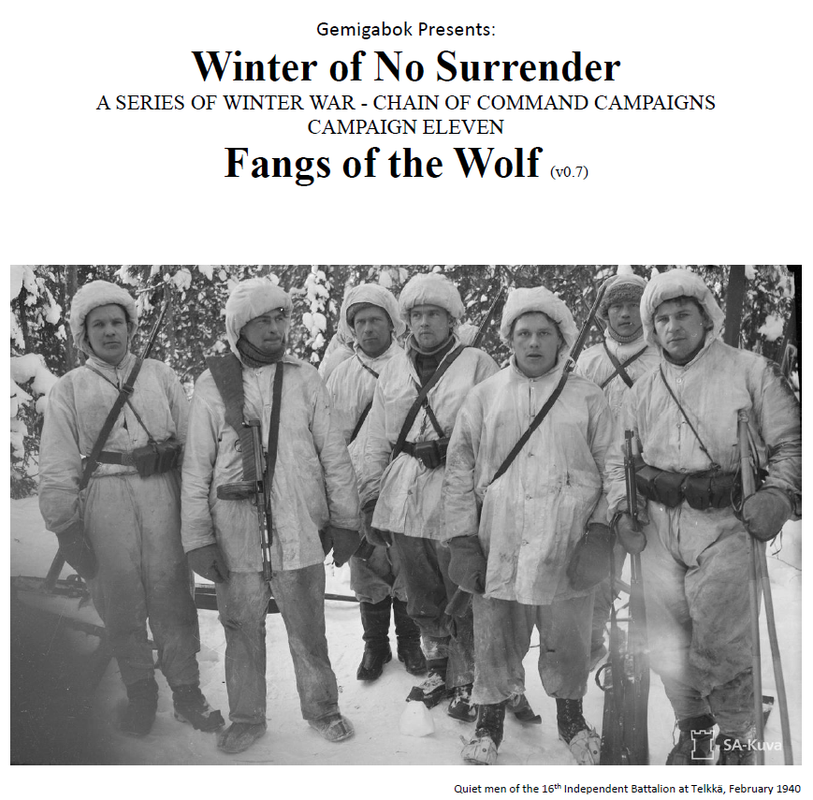

Fangs of the Wolf is my forthcoming Winter War Pint-Sized Campaign (PSC) for Chain of Command and other systems. We're set to begin playtesting it in a few weeks time.
Astute readers may notice that the new campaign is number eleven in the Winter of No Surrender series but that I've previously only released campaigns one and two. This is intentional and due to the fact that this campaign is set on a different front.
Even more astute readers may remember that our playtest of the first Winter of No Surrender campaign, Fire in the Sky, is not yet complete, the last game of that is still to be played. This is because the key Finnish player is MIA, we'll give him a few weeks to reappear and then play the last game, with or without him.
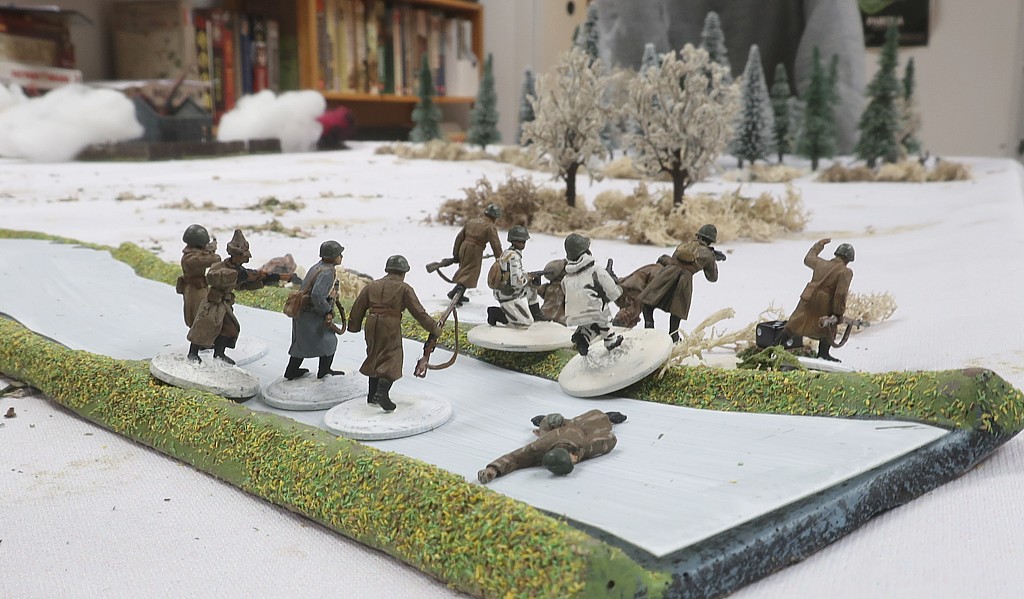
The WoNS series of campaigns is mainly intended for use with Chain of Command rules (with the At the Sharp End and Blitzkrieg 1940 Handbook campaign supplements and the Big Chain of Command supplemental rules) by Too Fat Lardies but are designed to be adaptable to other skirmish (platoon to company level) rule sets as well, including but not limited to Bolt Action, Battleground WWII, I Ain’t Been Shot Mum, Battlegroup, Nuts! and Disposable Heroes) and notes are included for that... In particular, if you are playing Easy Eight Enterprises' Battleground WWII, I will be able to provide you with unit statistics.
This campaign is designed to be played by an umpire and two or more players as the Finns and the Soviets. If there are only two people playing it is suggested that the Soviet player acts as the umpire.
 2.0 INTRODUCTION
2.0 INTRODUCTIONThe Red Army's plan of assault on Finland was complicated. Whole armies of the Soviet western military district were to simultaneously descend on the little country from multiple directions, forcing the Finnish Army to fight on many fronts at once.
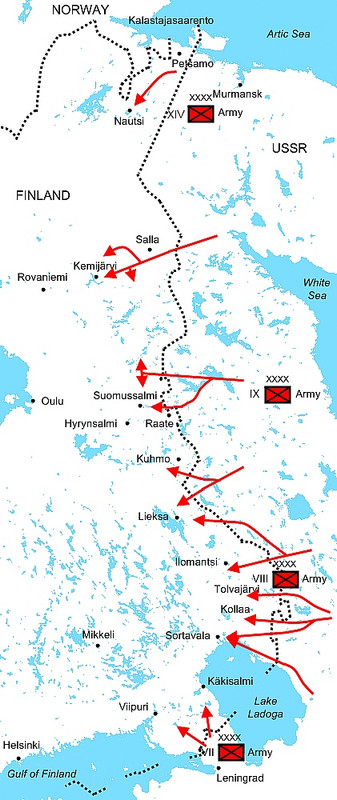
Public domain map by Peltimikko
The Soviet 9th Army was to cut Finland into two by advancing to Oulu through the Kainuu region, where Suomussalmi is located.
The road network in central and northern Finland was very sparse and generally rough going. One of these poor roads led from the frontier hamlet of Raate right through the tiny, northern-central Finland village of Suomussalmi.
In their pre-war contingency planning the Finns had considered the defense needs of the Kainuu region. They had concluded that because of the very primitive road network, harsh weather conditions and the remoteness of the whole region, it was extremely unlikely that the Red Army would conduct any major - let alone mechanized - operations there.
It was however deemed likely that the Soviets would dispatch ski patrols and the like to this region. Therefore, as the tensions between Finland and the Soviet Union were mounting, one company of border men was allotted to patrolling in the area. The company was stationed at way beyond Suomussalmi, some 30 kilometers from the frontier, and at any time only a single platoon keeping an eye on what was happening near the border.
On November 30, 1939 at 0700 hours the Soviet Union launched an invasion of Finland without declaring war. Unbeknownst to the Finns, two whole divisions of the Red 9th Army - the 163rd and the 44th - had been tasked with breaking through at Suomussalmi. At this point the Finnish Army had exactly one company of men defending the area.
THE 163rd INFANTRY DIVISION The 163rd Division was established in Moscow in August 1939. Its commander was Brigade Commander Andrey I. Zelentsov. The Division was part of the Soviet 9th Army [B97, p.130] it was composed of the 662nd Rifle Regiment (2930 men), the 759th Rifle Regiment (c. 3000 men) [B97, p. 112] as well as the 81st Mountain Infantry Regiment (1451 men), originally from the 54th Mountain Division.
It had 30 76mm artillery pieces and 12 122mm howitzers [B97, p. 112]. It was also supported by a Special Reconnaissance Company with 14 T-37A and two T-38 amphibious tanks, as well as two BA-27M armored cars []. In addition, there were T-26 tanks from the 365th Tank Battalion [B106].
The 163rd Division was inexperienced and ill-equipped [B108, p. ]. For example, despite the arctic temperatures, 40% of the men still had their leather boots, more suitable for summer weather [B98, p. ].
The main push of the 163rd Division's assault was north-east of Suomussalmi, by a place called Lonkka, where there wasn't even a road leading over the border. The vanguard of this attack would be the 81st Mountain Infantry Regiment, a unit especially suited to the arctic conditions, followed by the 662nd Rifle Regiment. The 759th Rifle Regiment would advance via Raate Road, the most predictable route to Suomussalmi.
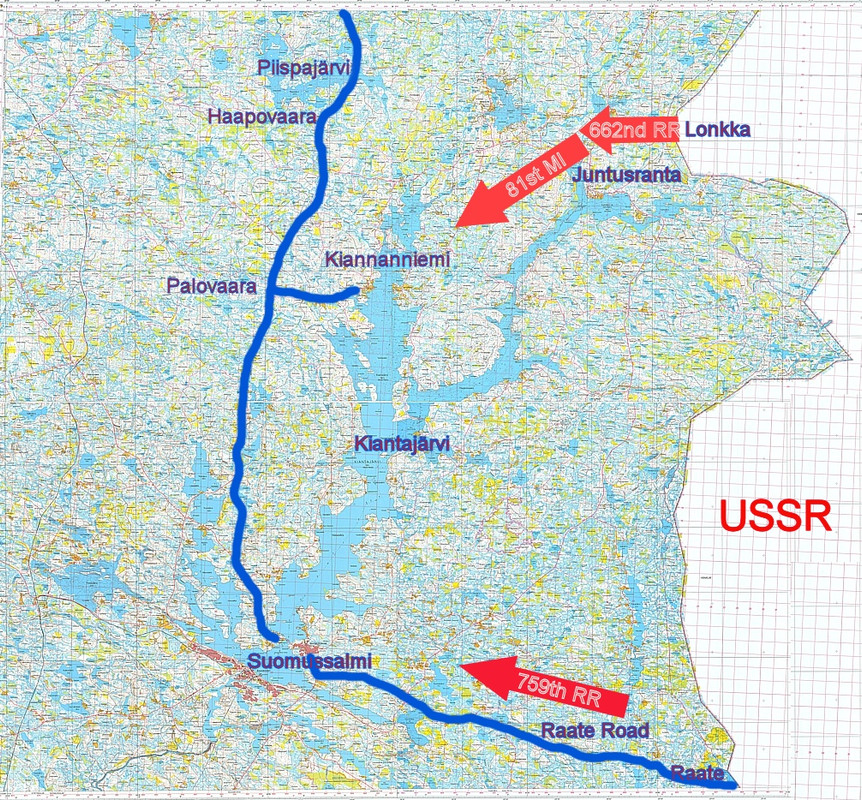
The scale is 1x1 kilometer squares.
THE 662nd RIFLE REGIMENT Like other regiments of the time, the 662nd was composed of three rifle battalions, one machinegun company, a regimental artillery battery, an anti-tank company, a reconnaissance company, plus gas protection, signals, supply and maintenance units. Its commander was Colonel Sharov, and the politruk Podhomutov.
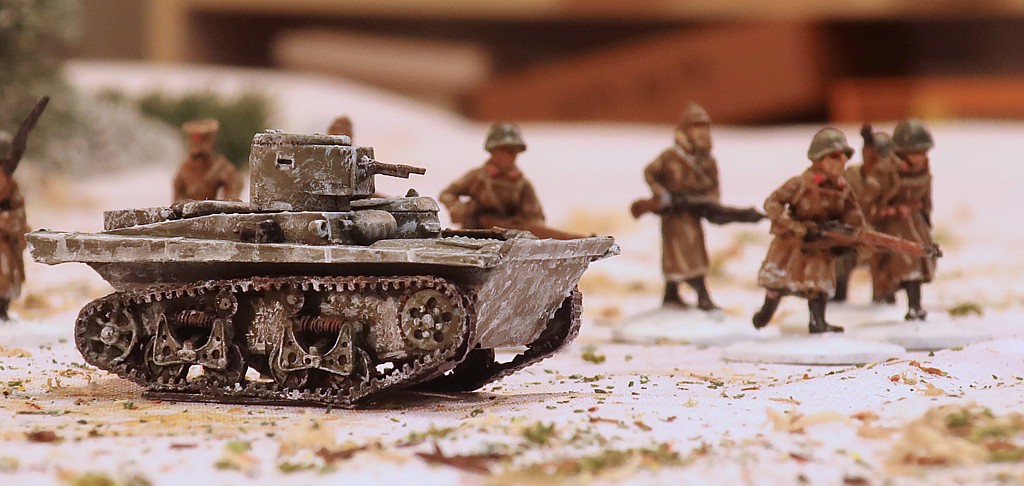 THE INITIAL BATTLES
THE INITIAL BATTLES The initial battles were predictable - the small Finnish forces near Juntusranta fell back under increasing Red Army pressure. As there wasn't even a road to the border there, the Finns at first thought that they were fighting a patrol, then a company, then a battalion. As more Finnish units were directed to the front, they could undertake ever stiffer resistance to the advancing Russians, yet they were still constantly being overpowered by the invaders. Soon they realized that they were fighting a whole Regiment, the 81st Mountain Infantry Regiment in fact.
It was then that they received most alarming news… on their right flank, another Soviet force - the 759th Rifle Regiment - was advancing from the direction of Raate. The Russians fought well. Their assaults were brave and augmented with forceful artillery barrages. The Finns fell further and further back, towards Suomussalmi. It was soon clear that the Red Army was attempting a pincer movement and would attack Suomussalmi from two directions.
 COMBAT GROUP SHAROV
COMBAT GROUP SHAROVOn reaching the crossroads at Palovaara on December 4th, the 662nd Regiment was split into two combat groups.
Combat Group Tchaikovsky, led by a lieutenant-colonel of the same name, continued southwards with the majority of the regiment's forces, while the regimental commander Colonel Sharov continued northward, towards the municipality of Kuusamo, with a slightly smaller force.
Combat Group Sharov consisted of one rifle battalion plus all of the regiment's HQ and associated support forces, a ski company, regimental artillery and anti-tank units, as well as supports from the 163rd Division - tanks and divisional artillery. In all, the force must have been larger than 1300 men.
 THE BIRTH OF A MOTTI
THE BIRTH OF A MOTTIWhile Combat Group Tchaikovsky struck south, Combat Group Sharov advanced north, pushing the defending Finnish forces before it. On December 6th, after some twelve kilometers of advance since the crossroads, the vanguard of the Combat Group reached the shore of Lake Piispajärvi, where they were stopped by stiff resistance. The defenders, a reinforced company from the Finnish 16th Independent Battalion on the other side of the frozen lake and fighting their first battle, had been able to set interlocking fields of fire for their machineguns and after several tries the Soviets found it impossible to cross here. They retreated some distance south and set up their own defensive perimeter. They would wait for reinforcements from the south.
This was as far as the 47th Army Corps would ever get.
Meanwhile, closer to Suomussalmi, fierce battles were raging. The 81st Mountain Infantry Regiment reached the village on December 7th and pushed the Finnish defenders onto the southern shore of the lake.
On December 17th, leaving one company to defend the northern positions, Lieutenant-Colonel Susitaival led the majority of his 16th Independent Battalion south through the woods. The journey took two days in terrible weather and very challenging terrain. On December 19th, he struck the Palovaara crossroads, ambushing a Soviet supply and reinforcements column, destroying it apart from two tanks which fled north.
Combat Group Sharov was now stuck in a
Motti encirclement some twelve kilometers long, stretching from Palovaara to Lake Piispajärvi. The Finnish word
Motti refers to a unit of firewood equal to one cubic meter. As a fighting technique, it is generally understood to mean isolating a superior enemy force from its supply, splitting it into smaller units and dealing with them one by one.
Of the around 1300 men in the encirclement, only about 300 would eventually escape, while another 200 would become prisoners of war. The rest of them are still there.